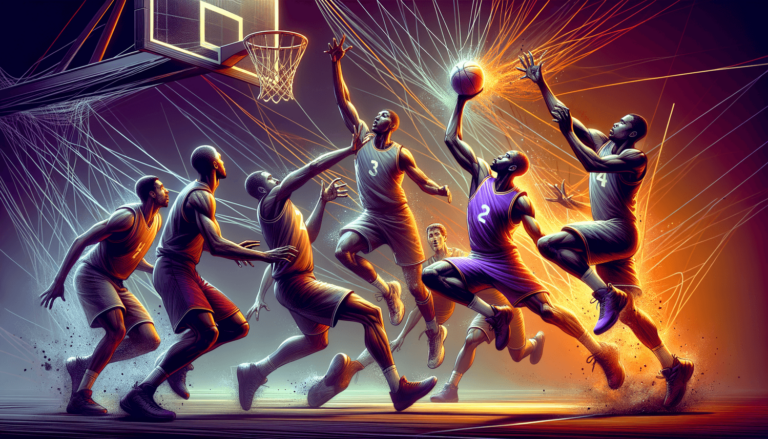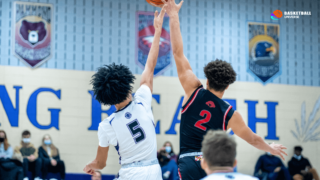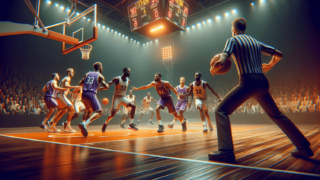
Basketball’s Offensive Rebound Rule: How It Affects Strategy
Written by: Basketball Universe
Last updated:

Calling all basketball aficionados and strategists – this one’s for you! We’re about to dive deep into the world of basketball’s offensive rebound rule, unraveling the layers of its impact on the game. In this jam-packed journey, we’ll dissect the intricacies of how this pivotal rule influences team strategies, turning the tides of games, and at times, even making history. So, lace up your sneakers, and let’s embark on a dynamic exploration into the captivating realm of offensive rebounding.
Basketball’s Offensive Rebound Rule: How It Affects Strategy
The offensive rebound rule in basketball ─ allowing a player from the attacking team to retrieve a missed shot before it touches the ground ─ significantly impacts a team’s strategy. It provides an opportunity for teams to extend their offensive possession and potentially score more points. Coaches often tailor their game plan to capitalize on this rule by positioning their players in the most effective manner, like placing taller or agile players nearer to the basket. This approach generates second-chance scoring opportunities, increases ball possession time, and disrupts opponents’ defensive patterns, ultimately shaping the outcome of games.
Understanding the Value of Offensive Rebounding
Before we delve into basketball’s offensive rebound rule, it’s important to comprehend the significance of offensive rebounding as a game-changing skill. An offensive rebound occurs when a team member retrieves the ball, following a missed field goal or free throw attempt by their own team. By securing an offensive rebound, the attacking team gains an additional opportunity to score, increasing the chances of winning the game. Seizing such rebounds is an art that requires a blend of height, athleticism, anticipation, and technique, making it an invaluable aspect of the sport. Let’s explore the nitty-gritty of the rule itself and how it shapes team strategies.
The Intricacies of the Offensive Rebound Rule
The fundamentals of basketball’s offensive rebound rule lie in the principle that a player from the attacking team can retrieve a missed shot before it touches the ground, effectively extending their offensive possession. This rule, part of the broader basketball rules, has a ripple effect on strategies deployed by teams, influencing the outcome of matches. Mastering this rule and understanding how it intertwines with various other facets of the game is crucial for teams looking to elevate their competitive edge.
The 24-second Shot Clock Reset
A crucial aspect of the offensive rebound rule centers around the 24-second shot clock. When a player secures an offensive rebound, the shot clock resets to 14 seconds, giving the attacking team additional time to attempt another shot. This abbreviated reset emphasizes the importance of making smart and quick decisions, as teams need to adapt and adjust their offensive strategies within the allotted period. Understanding the shot clock’s functionality enables teams to capitalize on the offensive rebound rule, making it a vital component to master.
Strategic Implications: Positioning and Roles
The offensive rebound rule creates a domino effect in the formation and positioning of players on the court. Tacticians and coaches are consistently searching for ways to exploit this rule, aiming to stack the odds in their favor. Let’s analyze how these strategic implications evolve and intertwine.
Player Positioning Around the Basket
One of the primary ways to capitalize on the offensive rebound rule is to optimize player positioning. The common tactic is to place taller athletes, like centers and power forwards, near the basket. Their height serves as an advantage, increasing the likelihood of grabbing a rebound. In addition, agile and versatile players, such as small forwards, can be positioned further away from the basket to stretch the opponents’ defense and offer a chance to grab long offensive rebounds.
Box-Out and Boxing-Out Strategy
The box-out strategy revolves around creating maximum space when positioning to grab a rebound. Offensive players aim to establish an advantage by boxing out their respective defenders, essentially blocking them from moving towards the ball when a shot is attempted. Mastering the art of boxing out can drastically improve a team’s offensive rebounding efficiency, enabling them to take full advantage of the rule.
Affected Offensive Strategies and Player Responsibilities
As the offensive rebound rule impacts player positioning and roles, it’s essential to consider how this rule influences team strategies and individual responsibilities. Numerous popular offensive strategies underscore the significance of focusing on offensive rebounding.
Crash the Boards Strategy
Crashing the boards is a technique where multiple players from the attacking team attempt to secure an offensive rebound. As soon as a shot is taken, these players move towards the basket, aiming to create multiple opportunities for their team to secure the rebound. This strategy relies on quick reflexes, athleticism, and a keen understanding of the game.
Secondary Break Strategy
The objective of the secondary break strategy is to fast-track into a fluid half-court offense after an unsuccessful fast-break attempt. In this situation, players should be prepared to rebound defensively, while also being ready to secure an offensive rebound if the opposing team misses a shot. By focusing on offensive rebounding within the secondary break strategy, teams can create additional scoring opportunities and maintain possession of the ball.
Defensive Counter Strategies
The offensive rebound rule’s potential impact on game outcomes warrants the development of defensive counter strategies. Opposing teams need to prioritize shutting down the offensive team’s rebounding efforts by employing tactics that neutralize the rule’s effectiveness.
Zone Defense and Preventing Offensive Rebounds
By implementing a well-orchestrated zone defense, a team can limit the opponent’s ability to obtain offensive rebounds. By assigning players to specific zones on the court, rather than specific offensive players, defensive teams can establish better positioning for defensive rebounds. However, this approach requires excellent communication and can be vulnerable to outside shooting if not executed correctly.
Defensive Switching and Blocking
Defensive switching and blocking involve trading defensive responsibilities during gameplay to counter the offensive team’s rebounding efforts. This tactic proves particularly effective against pick-and-rolls or pick-and-pops, as it allows defenders to maintain their position for rebounding opportunities by rapidly adjusting to the offensive player’s movements.
The Psychological Advantage
Apart from influencing team strategies and tactics, the offensive rebound rule holds a psychological effect on players as well. Teams able to successfully dominate offensive rebounds can demoralize and exhaust their opponents, granting them a mental edge on the court.
Momentum Swings and Morale Boosts
The excitement surrounding successful offensive rebounds stems from the fact that they often lead to momentum shifts, providing a significant morale boost to the attacking team. Converting such rebounds into points can frustrate opponents, disrupting their defensive focus, and hampering their overall performance.
Prolonging Defensive Efforts
When a team secures multiple offensive rebounds, it extends the time their opponents must remain in the defensive stance. This sustained effort can wear down the defensive players, leading to physical and mental fatigue. In turn, this fatigue can compromise the defensive team’s ability to perform and limit their capacity to stage a comeback if trailing in score.
Offensive Rebounding: A Dynamic Impact on the Game
It’s clear that basketball’s offensive rebound rule serves as a powerful influence on team strategies, player roles, and the psychological aspects of the game. By mastering the rule and deploying well-crafted strategies to optimize its potential, teams can tilt the balance in their favor, enhancing their chances of victory. The rule adds a unique layer of complexity and depth to the sport, making for an engaging and exciting display of skill, strategy, and talent.
Improving Offensive Rebounding Skills
As the offensive rebound rule significantly affects the game, developing the necessary skills to enhance a team’s performance in this area is crucial. Teams and players looking to boost their offensive rebounding prowess should focus on refining certain aspects of their game. Let’s lay out some fundamental skill-building techniques that can contribute to this endeavor.
Anticipation and Timing
Developing an innate ability to anticipate shots and the ball’s trajectory is an essential element of securing offensive rebounds. Players should study their teammates’ shooting habits and integrate various shooting drills to recognize patterns and anticipate misses. In addition, practicing timing to jump for rebounding opportunities can improve a player’s chances of obtaining the ball.
Strength and Conditioning
Strength and conditioning training can equip players with the physical prowess to overpower their opponents in battles for offensive rebounds. Incorporating exercises that focus on core and lower body strength, power, and endurance will significantly enhance a player’s ability to maintain a stable position within the court and successfully box out defenders.
Hand-Eye Coordination
Players should work on improving their hand-eye coordination, allowing them to maximize their chances of grabbing the ball promptly during rebound attempts. Various drills, like dribbling with multiple balls, catching tennis balls, or using reaction lights, can help enhance this aspect of a player’s skill set.
Notable NBA Performances and Records
Many NBA legends, past and present, have left their mark with exceptional displays of offensive rebounding prowess, showcasing the rule’s significance in basketball. Some standout performances and records emphasize the impact that stellar offensive rebounding skills can have on the game.
Dennis Rodman’s Rebounding Dominance
Dennis “The Worm” Rodman, a Hall of Famer, is widely regarded as one of the greatest rebounders in the history of the sport. With a relentless attitude and uncanny ability to excel in offensive rebounding, Rodman led the NBA in offensive rebounds for five seasons. His multiple 20-rebound performances, even in playoff games, attest to his immense impact on the court.
Moses Malone’s Prowess on the Boards
Another NBA legend, Moses Malone, held the record for the most offensive rebounds in NBA history with 6,731. The three-time MVP and Hall of Famer was known for his relentless pursuit of rebounds, making a lasting impression as a formidable force on the offensive glass.
Offensive Rebound Rule in International Basketball
Beyond the NBA, the offensive rebound rule also influences international basketball competitions like FIBA and the Olympics. Teams from various countries devise their strategies and styles, incorporating the offensive rebound rule to their advantage. The significance of this rule transcends boundaries, permeating every level of the game worldwide.
FIBA and 14-Second Shot Clock Reset
In international play, such as FIBA competitions, the 14-second shot clock reset after an offensive rebound has the same strategic implications as in the NBA. Teams are required to adjust their tactics and emphasize the importance of maximizing every additional possession obtained through offensive rebounding.
Olympic Basketball and Offensive Rebounding
During the Olympics, the offensive rebound rule is a vital aspect that impacts game strategies and outcomes. As national teams from different countries bring varying styles of play and tactics, capitalizing on offensive rebounds can often be a determining factor in distinguishing the best from the rest.
FAQ: Basketball’s Offensive Rebound Rule and Strategy
Are you eager to learn more about offensive rebounding in basketball? Here, we present a FAQ section featuring ten common questions related to the offensive rebound rule and strategy, offering insightful and concise answers designed for readers seeking additional information.
1. What is an offensive rebound in basketball?
An offensive rebound occurs when a player on the shooting team retrieves the ball following a missed shot by their own team, essentially extending their offensive possession and creating an opportunity for additional points.
2. How does the offensive rebound rule affect strategies?
The offensive rebound rule significantly impacts team strategies, as it elevates the importance of optimizing player positioning, mastering box-out techniques, and focusing on aggressive offensive rebounding tactics. Exceptional rebounding skills can boost a team’s performance and increase their chances of winning games.
3. Which players are typically responsible for offensive rebounds?
Centers and power forwards have the primary responsibility for securing offensive rebounds, as their height and physical presence are typically advantageous for such tasks. However, small forwards and even guards with exceptional athleticism, positioning, and anticipation may also contribute to a team’s offensive rebounding efforts.
4. What is the relationship between the offensive rebound rule and the shot clock?
Following an offensive rebound, the shot clock resets to 14 seconds, allowing the attacking team limited additional time to attempt another shot. This aspect highlights the importance of making efficient decisions and adapting strategies for reattempting shots within the time constraint.
5. What strategies can defensive teams employ to limit offensive rebounding?
Defensive strategies such as implementing a well-orchestrated zone defense, utilizing defensive switching and blocking, and focusing on effective communication can help counter the opposing team’s offensive rebounding efforts.
6. What drills can improve a player’s offensive rebounding?
Drills that focus on anticipation and timing, strength and conditioning exercises, and hand-eye coordination exercises can help players enhance their offensive rebounding skills by honing their reflexes, overall strength, and ball-grabbing abilities.
7. How do momentum swings factor into offensive rebounding?
Successful offensive rebounds often lead to momentum shifts, providing a morale boost to the attacking team. Converting offensive rebounds into points can frustrate opposing teams and disrupt their defensive focus, ultimately impacting the game’s outcome.
8. What is the “crash the boards” strategy in basketball?
The crash the boards strategy involves multiple players from the shooting team moving towards the basket to grab offensive rebounds simultaneously. This coordinated effort increases the attacking team’s chances of obtaining the rebound and creating additional scoring opportunities.
9. How do I create a shot opportunity after an offensive rebound?
Following an offensive rebound, players should be alert to kick the ball out to a teammate who is ready to take an open shot, pass it to a cutter, or go for a putback if they are in a good position. Quick decision-making and awareness of the team’s offensive formation are essential to maximize this opportunity.
10. What is the difference between NBA and international offensive rebound rules?
Although the offensive rebound rule remains largely similar across the NBA and international competitions like FIBA and the Olympics, variations in specific shot clock reset timings or game styles may exist. However, the strategic implications of the rule are consistent, with teams prioritizing offensive rebounding to optimize game outcomes.
Featured Posts
- No pillar pages found.





